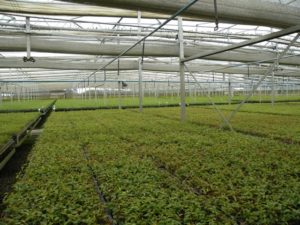A recent article in Forbes “Genetically Modified Poplar Trees Emit Fewer Hydrocarbons And Are Just As Hardy” (excerpted below) parrots much of the hype around the recent announcement that poplar trees have been genetically engineered to release less air pollution, yet grow just as well–as if this was the major problem with industrial tree plantations. But this alleged breakthough is just a red herring to deflect from the real issues and destruction caused by industrial-scale timber plantations.
Can the research be used to curb harmful emissions from other trees?
Yes, Monson says, especially for species like palm (used for palm oil production) and eucalyptus (used for wood and biomass production in tropical and subtropical areas).
“Many of the tree species that produce isoprene, like poplar, palm and eucalyptus are also used for cellulose and biomass production in agroforestry—mainly in plantations,” he explains.
“Thus, when plantations are located in the vicinity of urban or suburban areas, the isoprene can react with (nitrogen oxides) from the cars and produce ozone at relatively high rates. This is how trees produce air pollution.”
Why study poplars?
Well, poplar plantations cover 9.4 million hectares (more than 36,000 square miles) globally, including in the Pacific Northwest and Midwest in the United States. And worldwide, that’s more than double the land used 15 years ago. The trees grow fast and are a source of biofuel and other products including paper, pallets, plywood and furniture frames.
Meanwhile, millions of metric tons of isoprene leak into the atmosphere each year, according to University of Arizona officials. And climate warming will make the situation worse by increasing the rate of isoprene emissions, Monson says.
So what difference can genetically modified poplars make?
“A good estimate of the fraction of global isoprene emissions that come from agroforestry plantations is difficult, because the global databases on forest plantation coverage are not updated very well,” he explains.
“I would estimate that the percentage of emissions due to plantations is modest at the present time, but it is increasing rapidly due primarily to the increased global demand for palm oil and the interest in producing second-generation biofuels (those from cellulose production rather than fructose production) from poplar and eucalyptus.”
Pine plantations also are expanding, especially in the southeastern U.S., and the terpenes associated with that smell of pine also are hydrocarbons that can react with nitrogen oxides to produce ozone.
Genetically Modified Poplar Trees Emit Fewer Hydrocarbons And Are Just As Hardy
Trees don’t just emit oxygen as part of photosynthesis. Some, like the poplar tree, also emit gases which can harm air quality. But before you start clear-cutting, know this: Field trials in Oregon and Arizona show that poplars, which emit trace amounts of isoprene gas, can be genetically modified without stunting their growth.
That’s according to a research collaboration led by scientists as the University of Arizona, along with the Helmholtz Research Center in Munich, Portland State University and Oregon State University.
A lot of trees also emit isoprene and other gases. If you’ve ever smelled a pie forest, you’re smelling a group of complex organic molecules called terpenes, which are stored in the needles to ward off insects.
To read the entire Forbes article, click here

